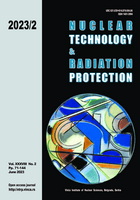
WASTE-SPECIFIC VOLUME FOR RETROSPECTIVE, PREDICTIVE ASSESSMENTS, AND RANKING OF PRACTICES DURING NORMAL OPERATION OF RUSSIAN NUCLEAR POWER PLANTS

Vol.
XXXVIII, No. 2, Pp. 71-144
June 2023
UDC 621.039+614.876:504.06
ISSN 1451-3994
Pages: 71-79
Authors: Denis D. Desyatov, Aleksey A. Ekidin, Konstantin L. Antonov, and Victor A. ShatalinAbstract
Possibilities of applying the generated radioactive waste-specific volume per unit of produced electricity are shown. This waste specific volume is used for retrospective assessment and forecasting of radioactive waste volumes generated at Russian nuclear power plants. According to the available data period covering 2008-2021, the mean and median values of the annual waste-specific volume for each nuclear power plant were obtained. The medians for solid radioactive wastes divided into the categories of very low-level wastes, low-level wastes, intermediate level wastes and high-level wastes are equal to 3.6·10–2, 3.2·10–2, 3.2·10–3, 3.0·10–4 m3(GWh)–1, respectively. For liquid radioactive wastes of the low-level waste and intermediate level waste categories – 1.3·10–3 m3(GWh)–1, 2.4·10–2 m3(GWh)–1, respectively. The highest mean and median values of waste-specific volume for all radioactive waste categories are typical for nuclear power plants with LWGR (RBMK) reactor installations. The forecast based on the plans to increase electricity production by Russian nuclear power plants indicates a likely increase in the volume of radioactive waste generation by 0.7-7.4 % (depending on the waste category) in the period from 2022 to 2027. The waste-specific volume use makes it possible to rank the existing practices of nuclear power plant operation by the volume of radioactive waste generation to justify the criteria for compliance with the International Project on Innovative Nuclear Reactors sustainability methodology.
Key words: radioactive waste, waste-specific volume, reactor facility, nuclear power plant, innovative nuclear reactor
FULL PAPER IN PDF FORMAT (605 KB)